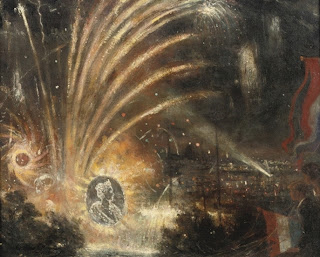
Self-portraits as a young man and elder statesman...
--------------------------------------------------------
David Abraham Bueno de Masquita (1889 - 1962) was born in Amsterdam and died in Florence, Italy in 1962. He was a well known painter, draftsman, wood-engraver, graphic artist, and illustrator of children's books. He studied at the Netherlands Royal Academy of Arts in Amsterdam under Theo Molkenboer and A.J. Derkinderen. He came from a talented family and shared his skills with his brother Jacques Henri Bueno de Mesquita. His oeuvre included landscapes, portraits, figural and mythological themes. In 1913 he took the Prix de Rome for his painting "
Jacob recognized the Bloodied Coat of Joseph". After winning the Prix de Rome he spend some time in Rome and Madrid traveling. From 1929 to his death he lived in Florence, Italy. This intaglio print (etching) came from a Gallery in Copenhagen, Denmark and is a beautiful example of his early figurative work.
---------------------------------------------
The Prix de Rome was a scholarship for arts students, particularly in painting, sculpture and architecture. It was created in 1663 in France during the reign of Louis XIV. The prize expanded after 140 years into five categories with the addition of music and engravers. The competition was exhausting and required artistic skills to accomplish. Notable recipients include: Francois Boucher, Carle van Loo, Jean-Honore Fragonard, Jaques-Louis David, Francoise-Xavier Fabre, Jean Auguste Dominique Ingres, Gustave Boulanger, Leon Perrault, Jean Lefeuvre, Pierre-Emile-Henri Jerome and Jean-Baptiste Carpeaux. Not so lucky also-ran's include: Eduard Manet, Edgar Degas, Ernest Chausson, and Maurice Ravel (Composers). Not too shabby, that bunch, for losers that is (he says tongue in cheek).
------------------------------------------


Caption:
Male Nude StudiesArtist: David Abraham Bueno de Mesquite (1889 - 1962)
Medium: Intaglio Print on paper, numbered 20
Dated: 1914
---------------------------------------------
Here are a few examples of Bueno de Mesquita's mature works:
 Boy scouts at Escorial, Spain
Boy scouts at Escorial, Spain ...1915
 Two Boys Volendamm
Two Boys Volendamm
 Palais des Beaux-Arts, Lille, France
Palais des Beaux-Arts, Lille, France












